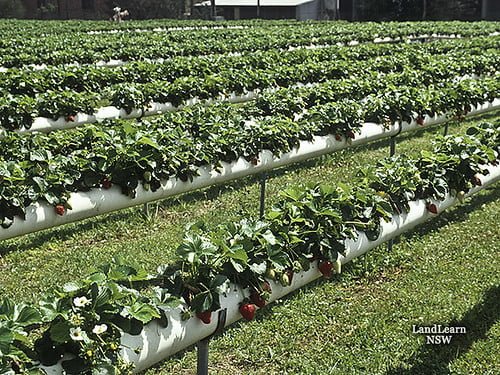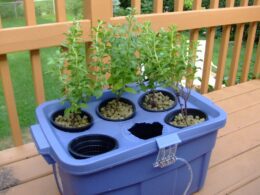Are you looking to grow your own fresh and healthy produce, but don’t have the space or resources for a traditional garden? Hydroponic gardening may be the answer you’re looking for. With this method, plants are grown without soil, using nutrient-rich water instead.
But what types of foods are best suited for hydroponic growing? Here’s a rundown of some of the most popular options that you can easily grow in your own hydroponic setup.
Leafy greens are some of the easiest and most popular crops to grow hydroponically. These include lettuce, spinach, kale, and arugula. Since they don’t require a lot of space or deep soil, they’re perfect for growing in a hydroponic system. Plus, since they’re often consumed raw, growing them without soil eliminates the risk of soil-borne diseases.
So if you’re a salad lover, hydroponic leafy greens are definitely worth considering.
Leafy Greens
You’re going to love how easy it is to grow fresh and crisp leafy greens right in your own home with hydroponic systems. Not only does it save you money, but it also ensures that you’re getting the highest quality produce possible.
Leafy greens such as lettuce, spinach, and kale are perfect for hydroponic growing, as they thrive in an environment with optimal growing conditions. One of the biggest advantages of growing leafy greens hydroponically is the nutritional benefits. These greens are packed with vitamins and minerals, and when grown in a hydroponic system, they can absorb all the necessary nutrients in a controlled environment.
This means that you’re getting the most out of your greens and can enjoy all the health benefits they have to offer. To achieve optimal growing conditions for your leafy greens, you’ll need to make sure that your hydroponic system is set up correctly. This includes providing the right amount of light, temperature, and nutrients.
With a little bit of research and some trial and error, you can easily grow a variety of leafy greens that will be both delicious and nutritious. So why not give it a try and see for yourself how easy it is to grow your own fresh produce with hydroponics?
Fruiting Vegetables
If you’re a fan of fresh and flavorful tomatoes, peppers, and cucumbers, then you’ll be happy to know that these delicious fruiting vegetables can thrive in a hydroponic setup. You’ll need to use different growing techniques for each type of vegetable, but don’t worry, it’s not too difficult.
For example, tomatoes require a trellis system to support the weight of the plant and fruit, while peppers and cucumbers can be grown on a simple vertical support structure.
When it comes to nutrient requirements, fruiting vegetables have higher demands than leafy greens. They need a balanced nutrient solution that provides adequate amounts of nitrogen, phosphorus, and potassium, as well as trace minerals like calcium and magnesium. It’s important to monitor the pH of the solution regularly to ensure that it stays within the optimal range for each type of plant.
With the right growing techniques and nutrient solution, you can enjoy a bountiful harvest of fresh and juicy fruiting vegetables all year round. Whether you prefer the sweetness of cherry tomatoes or the heat of jalapeno peppers, hydroponics offers a convenient and efficient way to grow your favorite crops. So why not give it a try and see for yourself how easy it can be to grow delicious and healthy produce at home?
Herbs
Get ready to add some fresh and aromatic flavors to your dishes as we dive into the world of hydroponic herb farming. Growing herbs hydroponically is a great way to ensure you always have a bountiful supply of fresh herbs right at your fingertips.
Hydroponic herb farming is becoming increasingly popular due to its numerous benefits. One of the benefits of hydroponic herb farming is the growing techniques used. Hydroponics allows you to grow herbs in a controlled environment, using a nutrient-rich water solution. This means that herbs can grow faster and healthier than traditional soil-based farming methods.
Hydroponic herb farming also requires less water and space, making it a more sustainable option. In addition to being sustainable, hydroponic herb farming also has numerous health benefits. Hydroponically grown herbs are free from pesticides and herbicides, making them safer to consume. Plus, you can control the nutrients your herbs receive, meaning you can grow herbs that are packed full of vitamins and minerals.
So, next time you’re looking to add some fresh and flavorful herbs to your dishes, consider hydroponic herb farming.
Is It Possible to Grow Onions Hydroponically?
Hydroponics offers a unique method for growing onions hydroponically, eliminating the need for traditional soil. By providing the necessary nutrients directly to the root system in a controlled environment, this technique allows onions to thrive. With the right setup, lighting, and nutrient solutions, success in growing onions hydroponically can be achieved, resulting in nutritious and flavorful harvests all year round.
Berries
Now, imagine having a bounty of juicy and flavorful berries right at your fingertips – that’s exactly what you can achieve with hydroponic berry farming! Growing berries hydroponically can be done in a variety of ways and with different techniques.
One of the best hydroponic systems for berries is the NFT (Nutrient Film Technique) system. This system involves a shallow tray or channel that is tilted slightly and nutrient-rich water is circulated over the roots of the plants.
Another growing technique for hydroponic berries is the Drip Irrigation system, which involves dripping nutrient-rich water onto the plants’ roots from above. This system is more commonly used for larger plants such as blueberries and strawberries.
Additionally, ebb and flow systems can also be used for berry cultivation, which involves flooding the roots of the plants with nutrient-rich water and then draining it away.
When it comes to which berries to grow hydroponically, strawberries, blueberries, and raspberries are the most commonly grown. However, blackberries, currants, and gooseberries can also be successfully grown using hydroponic techniques.
Hydroponic berry farming can be done all year round and in any climate, making it an ideal option for those who want to grow their own fresh produce at home.
Edible Flowers
You can add a burst of color and flavor to your dishes by incorporating edible flowers into your hydroponic garden. Edible flowers aren’t just beautiful to look at, but they can also be used in various culinary ways.
Some of the most common uses for edible flowers include using them as a garnish, adding them to salads, or even baking with them. Growing edible flowers for culinary purposes can be a great way to elevate your cooking game.
Some popular edible flowers to grow include pansies, nasturtiums, and violets. When growing edible flowers, it’s important to ensure that you aren’t using any pesticides or chemicals on them, as this can be harmful to both the flowers and you.
Incorporating edible flowers into your hydroponic garden not only adds beauty and flavor to your dishes, but it also allows you to have more control over the quality of the flowers you’re using. With a little bit of care and attention, you can have a beautiful and delicious addition to your meals right at your fingertips.
Frequently Asked Questions
What is hydroponic farming and how does it differ from traditional farming methods?
Hydroponic farming is a method of growing plants without soil, using nutrient-rich water instead. It differs from traditional farming methods in that it doesn’t rely on soil nutrients, but rather on a carefully controlled environment.
One advantage of hydroponic farming is that it allows for more precise control over the growing conditions, which can lead to higher yields and faster growth times. However, one disadvantage is the initial setup cost can be expensive. Another disadvantage is that if something goes wrong with the system, it can have a big impact on the crop.
Despite these drawbacks, hydroponic farming is becoming increasingly popular due to its potential to grow food in areas where traditional farming may not be possible.
What are some common challenges faced when growing plants hydroponically and how can they be overcome?
Growing plants hydroponically can be challenging, but there are solutions for hydroponic farming that can help optimize yields in hydroponic systems.
Common challenges include maintaining proper pH levels, preventing nutrient deficiencies, and controlling pests and diseases.
To address these challenges, it’s important to regularly monitor and adjust nutrient levels, use pest-resistant varieties of plants, and implement preventative measures such as air filtration and cleanliness.
With these solutions in place, hydroponic farmers can achieve high yields and healthy plants. So, if you’re looking to grow plants hydroponically, don’t let the challenges hold you back.
With the right approach, you can overcome these obstacles and enjoy the benefits of this innovative farming method.
What are the benefits of hydroponic farming, both for the environment and for consumers?
If you’re looking for a sustainable and efficient way to grow your food, hydroponic farming may be the answer for you. Not only does it offer a wide variety of crops that can be grown without soil, but it also provides numerous benefits for both consumers and the environment.
For consumers, hydroponic farming produces fresh and nutritious produce that is free from pesticides and other harmful chemicals. It also allows for year-round production, reducing the need for costly imports.
On the other hand, hydroponic farming is beneficial for the environment as it uses less water and space than traditional farming methods, and reduces the carbon footprint associated with transportation.
Overall, hydroponic farming is a smart choice that offers both health and environmental benefits, making it a great option for conscious consumers.
How does the nutritional value of hydroponically grown produce compare to conventionally grown produce?
When it comes to comparing the nutritional value of hydroponically grown produce to conventionally grown produce, there are a few key factors to consider.
One of the most important is nutrient absorption. Because hydroponic plants are grown in a nutrient-rich solution that is delivered directly to their roots, they are able to absorb a higher percentage of the essential nutrients they need to thrive. This can lead to higher levels of vitamins, minerals, and other beneficial compounds in the final product.
Additionally, hydroponic systems often have higher yield potential than traditional farming methods, which means that more produce can be grown in a smaller space. This can lead to fresher, more nutrient-dense produce that is available year-round, even in areas with limited access to fresh fruits and vegetables.
Overall, hydroponic farming offers a promising solution for those looking to improve their health and well-being through the foods they eat.
Can hydroponic farming be done on a large scale and if so, what are some examples of successful large-scale hydroponic farms?
Looking to invest in hydroponic farming on a large scale? It’s definitely doable, and there are plenty of successful examples out there.
Large scale hydroponic techniques have been used to grow profitable crops like lettuce, tomatoes, and cucumbers.
One of the most notable examples is BrightFarms, which operates hydroponic greenhouses that supply supermarket chains with fresh produce year-round. Another is AeroFarms, which uses vertical farming techniques to grow a variety of leafy greens and herbs in urban environments.
With the right expertise, resources, and technology, hydroponic farming can be a lucrative and sustainable way to grow crops on a large scale.
Conclusion
So, now you know what foods can be grown hydroponically! With this knowledge, you can start your own hydroponic garden and enjoy fresh, healthy produce at your fingertips.
Whether you want to grow leafy greens, fruiting vegetables, herbs, berries, or even edible flowers, hydroponics is a great way to do it. By growing your own food hydroponically, you can save money, reduce your environmental impact, and have fun experimenting with new plants.
So, get started today and see how easy and rewarding it can be to grow your own food without soil! Happy growing!








